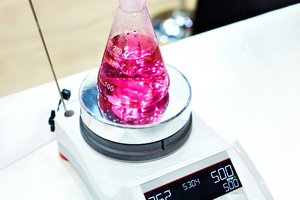In everyday life, individual, pure substances are rare to come by. We are much more often faced with their mixtures. Examples can include tea, milk or metal alloys. A mixture is a combination of two or more substances obtained by physical methods (which means there are no chemical bonds between them). If individual components of such a mixture can be recognised with the bare eye, then we call them heterogeneous mixtures. Otherwise, they are called homogeneous mixtures.

Properties of homogeneous mixtures
Homogeneous mixtures (also called uniform mixtures) are characterised by the fact that their components cannot be recognised with either the naked eye or simple optical instruments, such as a magnifying glass. The transformation of individual substances into homogeneous mixtures or the reverse process, namely the separation of a mixture into its individual components, occurs by physical processes called mixing and separation. All the substances that form a mixture maintain their original properties. They are characterised by the fact that there are no chemical bonds between them.
However, the components of homogeneous mixtures can have different physical states. Solutions are examples of such homogeneous mixtures. Their main component is the solvent in which the other components of the mixture are dissolved (or dispersed). In liquid solutions, the solvent is in the form of a liquid, however, in gaseous solutions the solvent is a gas, and in metal alloys it is a solid.
Methods of separating components of homogeneous mixtures
Homogeneous mixtures are formed by combining their components using physical methods. The choice of an adequate separation method depends primarily on the physical state of the individual components of the mixture. When mixed, the components of homogeneous mixtures retain their original properties. Such properties, too, influence the method of the mixture’s separation. These include density, solubility and the boiling point. Several examples of methods for separating homogeneous mixtures have been provided below.
Distillation
Distillation is an effective method for separating liquid components of homogeneous mixtures. Distillation requires relatively low boiling points of individual components and their thermal stability (to prevent degradation under high temperatures). In order to distill the individual substances, the mixture must be heated gradually in a distillation flask connected to a condenser. When the temperature is gradually increased, subsequent components of the homogeneous mixture start to boil (in a sequence that depends on their boiling points). They go from a liquid state to a vapour state, which is routed to a condenser. The cooling water flowing in it (in counterflow) cools down the vapours and condenses them. This way all the components of the mixture are distilled.
Crystallisation
The process of crystallisation is the opposite of distillation. It is used to precipitate the components of homogeneous mixtures into crystals, through controlled evaporation of the solvent. In the first step of the crystallisation process, as much solvent as possible should be evaporated in order to obtain a saturated solution. Then the solution is then being cooled. As the temperature is lowered, it becomes supersaturated and crystals of the original substance dissolved in the solution slowly start to grow. In strictly defined and controlled conditions, the crystallisation process results in obtaining crystals of a large size, desired shape and high purity (even over 99%).

Adsorption
The separation of homogeneous mixtures (gaseous or liquid) may also be achieved by adsorption. The process uses the capacity of certain substances to absorb other components (e.g. the constituents of the mixture). Such an “absorber” is called an adsorbent. It binds molecules of the adsorbate (the dissolved substance that is adsorbed) on its surface as a result of interactions of physical (physical adsorption) or chemical (chemical adsorption, or chemisorption) nature. Solids that have a highly developed specific surface area are most often used as adsorbents (which increases separation efficiency). Activated carbon is often used for this purpose.
Paper chromatography
It is a chromatographic technique that can be used effectively to separate the components of a homogeneous mixture. It enables, for example, to separate the components of ink in markers. In order to do this, the mixture must be applied to the bottom of a special chromatography paper (starting line). Then the substrate with the applied mixture is placed in chambers filled with a solvent (called eluent) at the bottom. Thanks to capillary forces, the eluent rises along the blotting paper, taking the mixture with it. Its specific components interact with both the substrate and the solvent differently, which will eventually lead to separation.
Homogeneous mixtures: examples
Petrol is a common example of a liquid homogeneous mixture. It consists of hydrocarbons whose molecules contain from 5 to 12 atoms of carbon. These mainly include alkanes, so saturated compounds. Petrol also contains unsaturated aliphatic compounds – they have double or triple bonds between the carbon atoms – and cyclic compounds.
A homogeneous mixture that is essential for human life is air. Clean, unpolluted air is a combination of various elements and chemical compounds. Its basic components include nitrogen, oxygen and noble gases. The remaining components of this gaseous mixture vary in content depending on a number of factors. These include carbon (IV) monoxide, ozone, sulphur and nitrogen oxides, water vapour, hydrogen and methane.
Chemical solutions of salt in a solvent are also homogeneous mixtures. An example of such a mixture is brine. It is formed as a result of a physical process of dissolving sodium chloride (table salt) in water. Brine is widely used, for example, in the food industry. The amounts of each component (NaCl and H2O) can be specified by indicating their concentration in the solution.
